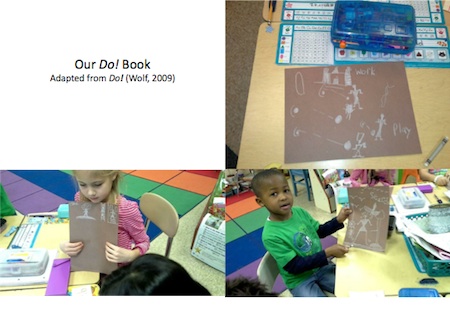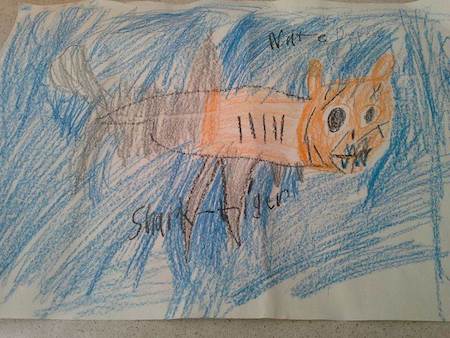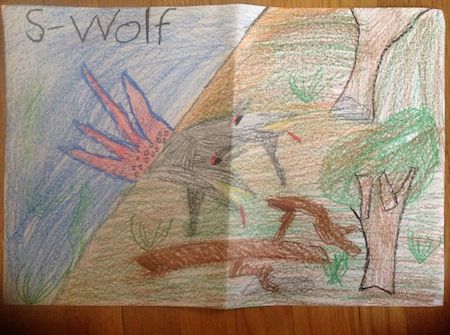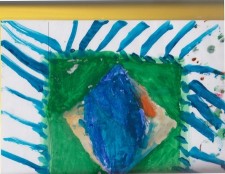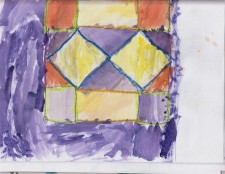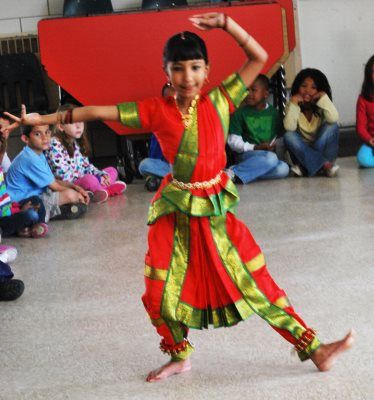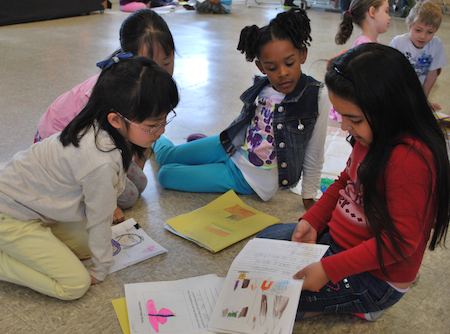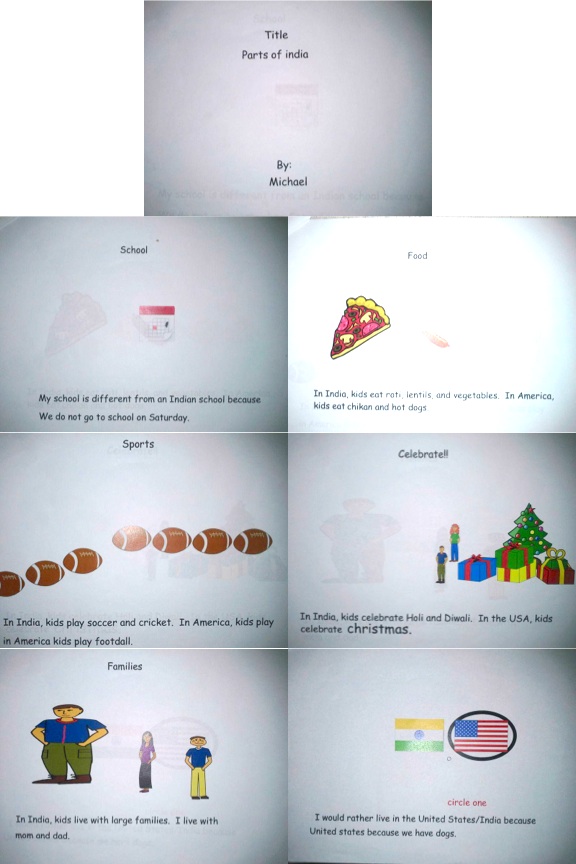Crossing Cultural Borders More Deeply: Integrating a Study of India Throughout the Curriculum
by Laura Fuhrman
Our first grade team started the 2012-2013 school year helping students explore who they were as cultural beings and developing an appreciation of their own and others’ uniqueness. With that understanding we moved to a cross-cultural study of India as we had the previous year (Clarke-Williams, 2012). In 2011-2012 we found our cross-cultural study of the ways people live and think in India helped students come to respect and appreciate “what it is to be human” (Collins, Czarra, & Smith, 1998) as well as the differences that make Indian and American cultures unique (Doyle, 2012). We wanted to explore this further with our first graders in 2012-2013. This vignette describes our India study in my classroom and how, with the help of the special area teachers, we integrated this cross-cultural study more fully into the curriculum for all of the first grade classes.
Learning About India in First Grade
Building on our previous work, we decided to add more literature to the India unit by including materials we had from our school library along with enriching materials from the previous year. We divided the books into six text sets and stored them in tote bags, which we rotated among all the first grade teachers. The text sets included sets of literature organized around the following themes: Culture and Traditions, Cities and Villages, Land and Resources, Animals, People, and Children. Each text set included nonfiction books, folktales, and one art book that highlighted an Indigenous group in India and had illustrations that used a specific artistic technique.
Each of the teachers had a text set for one week. During the week we read books to the whole class and children used the books for research in small groups. The children recorded information they found important in “graffiti notes” on large pieces of paper divided into four sections on one side with two additional sections on the other side (Clarke-Williams, 2012). The slides in Figure 1 show examples of graffiti notes for the Land and Resources text set.
At the beginning of each week I started text set inquiries by sharing the books I felt provided context and information the entire class needed to understand for that particular topic. As a class, we kept a web on India that we added information to weekly. I also shared the folktale for that week and children summarized by using Sketch-to-Stretch (Short, Harste, & Burke, 1996) to show their understandings. The following days the children met with a partner to find and discuss information they learned in the books and to decide what to draw and label on their graffiti notes, adding details independently to their own notes.
Learning About and Experiencing Indian Art
Each text set had a book that presented an art form from India. Due to time constraints no class was able to go into depth with each of the art books, but we read and experienced two art forms in depth in my classroom.
The first book we explored artistically was Do! (Wolf, 2009). Each page of the book has a verb representing actions taken in the Warli tribe. The verb has several drawings in brown and white Warli art that show aspects of the tribe’s daily life. My class decided to make our own book after reading and discussing Do! together. Each child took a verb, such as play, work, wash, etc., that showed their daily actions and illustrated it with Warli art figures using white crayon on brown construction paper. The photographs in Figure 2 show pages from our book.
The second book we explored artistically was That’s How I See Things (Wolf, 2007) about looking at things in a different manner. Wolf, the author, saw animals with two different animal body parts. The book’s artists, Rao and Shyam, created illustrations using many colors and added details with only black. After we read and discussed the story and illustrations, students created their own animals on white construction paper using different animal body parts and the same art technique. They named their animals and wrote about where they lived and what they ate. Examples from Nate and Ronnie are below.
Nate created a “Shark-tiger” (see Figure 3) and wrote, “Shark-tiger is wild. And it is scary. It can hunt very fast and snatch its’ food very fast. It can even go in loopty-loops. It lives in a shark-tiger den. It eats squid and cheetahs. There’s one in the water and one on land. “
Ronnie made a “S-Wolf” (see Figure 4). He wrote, “My animal is called S-Wolf. It eats meat and crabs. It drinks water. It lives in the middle of the seawoods. It has the legs of a squid and the heads of a wolf.”
In addition to the text set books related to art in India, we worked closely with Stacy, our art teacher, to explore different types of art in India. Stacy describes her focus on art in India in her curriculum:
In my first grade classes, we started the India unit by looking at an art form in India called rangolis. Rangolis are a form of decoration created by dropping a rice flour mixture on the ground commonly found in front of houses or steps. They can be created with just a white color or different patterns of bright colors. We read Rangoli: Discovering the Art of Indian Decoration written by Anuradha Ananth (2011) and illustrated by Shailja Jain.
We talked about the kinds of lines and shapes we saw in the rangolis and practiced a simple rangoli on a worksheet. This rangoli was created by using a grid of dots in a square shape. After students engaged with this guided rangoli, they created their own designs using the same grid of dots. The next few rangolis the students drew were created without using the grid of dots. They had worksheets to look at while they created their own rangoli that had a design filled with Indian decorations. At the end of class, students chose their favorite and most successful rangoli design.
In the next class, students took their small rangoli design and redrew it on a larger paper. They took oil pastels and traced the lines. Once they were finished with oil pastels, they filled in the rest of the design with watercolor. We looked at the book once more and decided it would be best to use bright colors and patterns since the rangolis we studied used bright colors and patterns as well. Examples of rangolis are below..
Students drew an Indian house and apartment building and then a car, person, and an animal somewhere in the foreground of their cover. In the next class, they drew shapes on their ground and painted them in with watercolor. They also painted in one of their houses. Once the paint was dry, they took permanent black marker and outlined everything. In the final class, students took construction paper and cut out a tree to include on their cover. Titles were glued onto their cover and the cover was bound to their book.
As Stacy mentioned, students wrote books about India based on what they’d learned.
My students’ books compared India and America on facing pages. After six weeks of an extensive learning they began composing their rough drafts comparing India to the U.S.
When starting the writing process I modeled writing my rough draft. I started with the first text set topic and wrote something I learned about people in India by referring to my graffiti notes. Then I wrote a fact on my America page that stated how it was different in my life. All the children started with the same topic on the first page. They used their graffiti notes to think about what they wanted to write and continued at their own pace with the pages that followed, conferring with me individually. Some children received additional assistance when needed. I also had parent volunteers who assisted at times. After all the pages were completed at the rough draft stage children completed final copies at their own pace adding detailed illustrations to each page. Each student had six pages, one for each text set/topic mentioned above, about India and six pages about America. The India pages were bound to the cover on the left edge of their books and the America pages on the right edge. That way when the books opened the India and America pages were side-by-side to create a flip book (see Figure 7). The children created the covers for the India side and America side in art class and were then laminated. A few pages from Sarah’s book are in Figure 7.
Celebration Time
We scheduled a morning to use the cafeteria to have an India celebration, inviting parents from India to share information with children. A few days before, children in our classes wrote questions to the parents and the parents used the questions to organize their presentations. For example, Jordian, from my class, asked “What does chapatti taste like?” and “Have you visited the Taj Mahal?” Two fathers and two mothers came wearing native clothes. Three students also wore native clothing. Two of them, Leah in second grade and her cousin Ariel in fifth grade, danced a contemporary Bharatnatyam Indian dance. Leah’s picture is in Figure 8.
Following the presentations, students got into small groups with students in one of the other first grade classrooms to share their India books (see Figure 9). They all enjoyed learning from each other and sharing their accomplishments!
Learning About India in Special Area Classes
To immerse our students more deeply in Indian culture, in addition to working with Stacy for art, I emailed all the special area teachers as the first grade chair this year, explaining our study and asked if they could integrate India into their work with children. The special area teachers were eager to collaborate with us and support our students’ learning and found ways to weave aspects of Indian culture into their curriculums.
Music:Tammy, the music teacher, researched Indian music and found a song that children sing in India. She taught our first graders that song and they learned to sing it.
Technology: Bethany, the technology teacher, showed the children how to research India and presented them with a Pixie slideshow about Indian culture that had text and pictures. The text was read to ESL and below-grade level students using a voice recorder. Students then used the information to create their own slideshows. They added graphics to support their self-written text and recorded their voices reading the presentation. They also printed this out into book form. Michael’s book is in Figure 10.
Physical Education: While researching the country of India my students found out the children in India play some different games. During physical education class the student teacher taught the children some of these games.
The children’s learning and experiences with India in the special area classes added to their knowledge and understandings of India. Immersed in learning about and experiencing aspects of Indian culture allowed them to cross cultural borders and understand more how they fit into our pluralistic world (Cai, 2002). Through the study of India the children developed “conceptual understandings of culture [and] realized that their cultural perspectives were only one of many ways to view and live in the world” (Short & Thomas, 2011, p. 156).
References
Aghalarov, S. (2012). Learning to read and compose meaning in art using picturebooks.
WOW Stories, IV(5). http://wowlit.org/on-line-publications/stories/iv5/8/
Ananth, A. (2011). Rangoli: Discovering the art of Indian decoration. Illus. by S. Jain. London: Frances Lincoln.
Cai, M. (2002). Multicultural literature for children and young adults. Westport, CT: Greenwood Press.
Clarke-Williams, M. (2012). Crossing cultural borders: Our study of Indian culture. WOW Stories, IV(5). http://wowlit.org/on-line-publications/stories/iv5/6/
Collins, H.T., Czarra, F.R., & Smith A.F. (1998). Guidelines for global and international studies education. Social Education, 62(5), 311-317.
Doyle, M.H. (2012). Empowering young writers as authors and illustrators through a study of India. WOW Stories, IV(5). http://wowlit.org/on-line-publications/stories/iv5/7/
Krishnaswami, U. (2010). Out of the way! Out of the way! Illus. by U. Krishnaswamy. Berkeley, CA: Groundwood Books.
Short, K., Harste, J., & Burke, C. (1996). Creating classrooms for authors and inquirers. Portsmouth, NH: Heinemann.
Short, K., & Thomas, L. (2011). Developing intercultural understandings through global children’s literature. In R. Meyer & K. Whitmore (Eds.), Reclaiming reading: Teachers, students, and researchers regaining spaces for thinking and action (pp. 149-162). New York: Routledge.
Wolf, G. (2007). That’s how I see things. (Illus. by S. Rao & B. Shyam). Chennai, India: Tara Books.
Wolf, G. (2009). Do! (Illus. by R. Hengadi, R. Hengadi, S. Dhadoe, & K. Dhadoe). Chennai, India: Tara Books.
Laura Fuhrman teaches first grade at Pot Spring Elementary School in Timonium, Maryland.
Stacy Aghalarov teaches art at Pot Spring Elementary School in Timonium, Maryland
WOW Stories, Volume IV, Issue 7a by Worlds of Words is licensed under a Creative Commons Attribution-NonCommercial-ShareAlike 4.0 International License.
Based on a work at <a href="wowlit.org/on-line-publications/stories/storeisiv7a".


